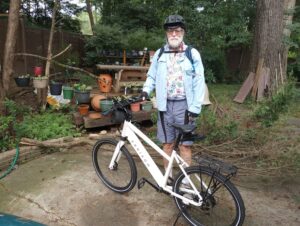
Cars like wide roads. They’re noisy, they’re dirty. But we’re locked in our cars and don’t notice.
We don’t notice, that is, until we get home. Then we want to be separated from those noises and that dirt. Quiet is a luxury good. Any residential property along the main road sells at a discount.
This makes it hard for suburbs to accept e-bikes and other alternate transportation that city dwellers like.
I live near this urban design border. Wide through streets exist, but in my neighborhood, you can still drive around a block. There are many alternate routes through the neighborhood. Ride two miles to the east, or a mile to the north, and it changes. There’s only one way through, with 5 lanes of traffic including a turn lane. It’s very dangerous. As the south side of Atlanta develops, it replicates this design, locking in the suburban pattern of cul de sacs and highways.
In any suburban road design of the last 50 years, living with an e-bike seems impossible. This is how most of metro Atlanta, and all Sunbelt cities, operates. The few through routes are filled with cars, and all residents are thus resistant to alternatives. You take your life in your hands. You’re not going to let your kid bike to school. You’re not hopping on an e-bike to go to Costco.
Change the Suburbs

Suburbs need dense centers. Most suburbs are centered around huge shopping centers and their parking lots. But many also have older, pre-war centers, and all of them have schools. The centers need to be given density, four-story blocks with housing and shops below. You then need bike routes that go from the low-density parts of town to these higher density areas, and the schools. Then you connect suburbs using this infrastructure.
This means we need a safe way through more subdivisions. We need to find a way to push bike paths through what are now cul de sacs. This is going to be much, much harder than density is. You’re talking about taking side yards, against stiff resistance. But if we have enough people using the spokes to the suburban hubs, we can build a constituency for it.
We’re still in the early adopter phase of e-bike use in the U.S. Getting through the mass market is going to take policy support. Otherwise, we’ll be as locked in our Teslas tomorrow as we’re locked into our Chevys today.










